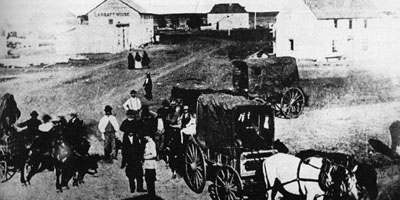by Bruce Cherney (part 3)
At his trial, Gordon was said to have answered each question with composure and dignity. But Gordon’s downfall came when Jay Gould’s attorney, David Dudley Field, started to ask questions about his family. He gave the names and addresses of an alleged stepfather, a brother-in-law and an uncle. Cables were immediately sent to the American consulates in Paris, London and Berne, Switzerland, asking staff to investigate the information provided by Gordon. The investigators replied to the cables from New York that no such persons or addresses existed in the respective cities.
According to George Bryce, Gordon Gordon was the illegitimate son of a “cultivated Englishman, who sent him to a london boarding school, under the name of John Hamilton. The boy was then sent into trade, and soon scandalized himself by obtaining goods under false pretenses.”
Bryce said Gordon next surfaced as an assistant master in a school in Sommerset, but quit to partner with a country lawyer to purchase an estate, “but had nothing to pay, and of course returned it.
“He then assumed the role of a clergyman, and in London for some time followed the sacred office, but was discovered to be an impostor. His career for a few years after this escapade is unknown, but he reappeared as Herbert Hamilton.”
In 1867, he adopted the name of Herbert Glencairn, claiming to be the heir of the Scottish earldom of Glencairn.
“The operator now sought a wider sphere. He made a connection with a legal firm of the Metropolis, whose leading figure was Mr. (Howard) Paddison.
“To him he was known as ‘Glencairn.’
“With this firm he deposited a number of large boxes, declaring them to contain valuable plate, jewelry and title deeds belonging to his family. These boxes bore in gold letters the name ‘Right Honorable Lord Glencairn.’”
Gordon went to Scotland for the shooting season under the name Hamilton, where he gained more friends by exploiting his “pleasant manner.”
In the following year, he returned to Scotland using the title “Glencairn,” and became a friend of J.W. Simpson, the Free Church minister in Glenisla.
“His manner was not to tell any one directly who or what he was, but to make statements which led you to infer that he was a man of title and had property in various places in Scotland, England and Ireland,” wrote Simpson in a letter to the New York court dated October 3, 1872.
Through Simpson, Gordon was introduced to the goldsmiths and jewelers, Marshall and Son of Edinburgh, as Lord Glencairn. In London, he was introduced to the diamond merchants Kellers.
“At one time,” wrote Bryce, “the Edinburgh and London jewelry firms became anxious about his extravagant orders and his failure to meet his bills, but on a conference with them he succeeded in quieting them.”
He then obtained a loan of £25,000 from Paddison under false pretenses, after which he allegedly fled to Scotland, but he could not be found there.
When the jewelers came knocking, an embarrassed Paddison returned the items that had been presented as gifts to him from Gordon, but there were still some pieces missing and presumed to be in the possession of the fleeing felon.
At this stage, the bogus lord was on his way to the U.S. in pursuit of bigger fish to con.
(Next week: part 4)



